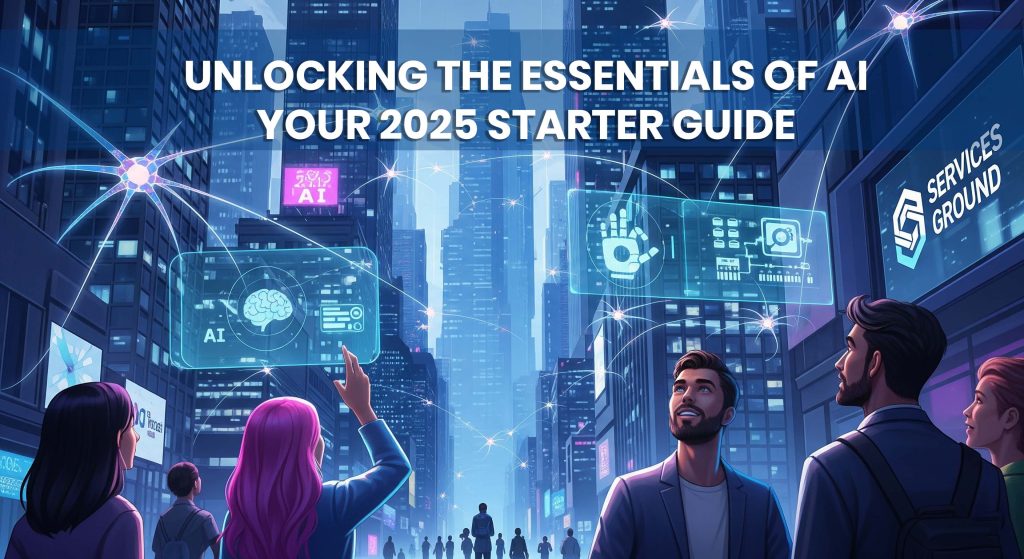AI is Not Just for Tech Giants Anymore
In 2025, the conversation around Artificial Intelligence has shifted dramatically. What was once perceived as a technology exclusively for tech giants and highly specialized research labs is now a powerful, accessible tool for businesses of all sizes. For entrepreneurs and business owners, understanding how AI can drive value, improve efficiency, and unlock new opportunities is no longer a competitive advantage—it’s a necessity for survival and growth. This guide is tailored to help you, the business leader, navigate the AI landscape of 2025, focusing on its practical applications, measurable benefits, and responsible integration into your operations.
The rapid advancements in AI, particularly in areas like Large Language Models (LLMs), image generation, and autonomous agents, mean that AI solutions are more user-friendly and impactful than ever before. From automating mundane tasks to providing deep customer insights and revolutionizing marketing efforts, AI offers a myriad of ways to enhance your business. However, with these opportunities come questions: Where do I start? What’s the real return on investment (ROI)? And how do I ensure I’m using AI ethically and responsibly?
This blog post will address these critical questions. We’ll explore the tangible business value proposition of AI, delve into how to measure its impact through key ROI metrics, and discuss the crucial aspects of responsible AI deployment within your organization. Our goal is to equip you with the knowledge to confidently assess, adopt, and leverage AI to achieve your strategic business objectives in 2025 and beyond.
The Business Value Proposition of AI: More Than Just Automation
At its core, AI offers businesses a transformative set of capabilities that extend far beyond simple automation. While automating repetitive tasks is a significant benefit, the true value of AI lies in its ability to:
1. Enhance Decision-Making
AI can process and analyze vast amounts of data far more quickly and accurately than humans, identifying patterns and insights that would otherwise be missed. This leads to more informed, data-driven decisions across all business functions, from optimizing supply chains and predicting market trends to personalizing customer experiences and identifying new revenue streams.
2. Improve Efficiency and Productivity
By automating routine, time-consuming tasks, AI frees up your human workforce to focus on more strategic, creative, and high-value activities. This not only boosts individual and team productivity but also reduces operational costs and streamlines workflows. Examples include automated customer support, intelligent document processing, and predictive maintenance.
3. Drive Innovation and New Business Models
AI is a catalyst for innovation. It enables the creation of entirely new products, services, and business models that were previously unimaginable. Think of personalized learning platforms, AI-powered drug discovery, or generative design for manufacturing. Businesses that embrace AI are better positioned to disrupt markets and create new value propositions.
4. Personalize Customer Experiences
In today’s competitive landscape, personalized experiences are key to customer loyalty. AI allows businesses to understand individual customer preferences, behaviors, and needs at scale. This enables hyper-personalized marketing campaigns, tailored product recommendations, and highly responsive customer service, leading to increased engagement and satisfaction.
5. Optimize Resource Allocation
AI can analyze complex variables to optimize the allocation of resources, whether it’s inventory management, workforce scheduling, or energy consumption. This leads to significant cost savings, reduced waste, and improved operational agility.
6. Enhance Security and Risk Management
AI-powered systems can detect anomalies and potential threats in real-time, significantly enhancing cybersecurity measures and fraud detection. Predictive analytics can also help businesses anticipate and mitigate various risks, from financial volatility to operational failures.
Measuring AI’s Impact: Key ROI Metrics
Implementing AI is an investment, and like any investment, it requires a clear understanding of its return. Measuring the ROI of AI can be more nuanced than traditional IT projects, as its benefits often extend beyond direct cost savings to include improved customer satisfaction, enhanced innovation, and better decision-making. Here are key metrics to consider:
1. Cost Reduction
- Operational Cost Savings: Direct savings from automating tasks, reducing manual labor, and optimizing processes (e.g., reduced call center costs due to AI chatbots, lower energy consumption from AI-optimized systems).
- Waste Reduction: Savings from optimized resource use, predictive maintenance preventing equipment failures, and improved inventory management.
2. Revenue Growth
- Increased Sales/Conversions: Attributable to personalized marketing, improved product recommendations, and enhanced customer experience.
- New Product/Service Revenue: Revenue generated from AI-powered offerings or business models.
- Market Share Expansion: Growth in market share due to competitive advantages gained through AI adoption.
3. Efficiency and Productivity Gains
- Time Savings: Hours saved by employees due to automation of routine tasks (e.g., faster data processing, automated report generation).
- Throughput Increase: Higher volume of work processed (e.g., more customer queries handled per hour, faster content creation).
- Error Rate Reduction: Decrease in human errors due to AI-assisted processes.
4. Customer Experience (CX) Improvements
- Customer Satisfaction (CSAT) Scores: Improvement in satisfaction levels due to faster service, personalized interactions, and better problem resolution.
- Net Promoter Score (NPS): Increase in customer loyalty and willingness to recommend.
- Customer Churn Rate: Reduction in the rate at which customers stop doing business with you.
5. Innovation and Strategic Impact
- Time-to-Market for New Products: Reduction in the development cycle for new offerings.
- Data-Driven Decision Quality: Qualitative and quantitative improvements in strategic decisions.
- Employee Engagement/Satisfaction: Improved morale and retention due to reduced mundane tasks and focus on higher-value work.
To effectively measure ROI, it’s crucial to establish clear baseline metrics before AI implementation and continuously track these KPIs. A balanced scorecard approach, combining financial, operational, and strategic metrics, often provides the most comprehensive view of AI’s impact.
Responsible AI Deployment in Organizations: Building Trust and Sustainability
As AI becomes more integral to business operations, deploying it responsibly is not just an ethical obligation but a strategic imperative. Irresponsible AI can lead to reputational damage, legal liabilities, and erosion of customer trust. Here are key considerations for responsible AI deployment:
1. Transparency and Explainability
- Be Clear About AI Use: Inform customers and employees when they are interacting with AI systems. Transparency builds trust.
- Understand AI Decisions: For critical applications, ensure you can explain how an AI system arrived at a particular decision. This is vital for accountability and auditing, especially in regulated industries.
2. Fairness and Bias Mitigation
- Audit for Bias: Regularly assess your AI systems for biases in their data and algorithms that could lead to discriminatory outcomes. This requires diverse datasets and rigorous testing.
- Promote Equity: Design AI systems to promote fair and equitable outcomes for all users, actively working to identify and correct any disparities.
3. Privacy and Data Governance
- Data Minimization: Collect only the data necessary for the AI’s function.
- Robust Security: Implement strong data security measures to protect sensitive information used by AI systems.
- Compliance: Adhere to all relevant data privacy regulations (e.g., GDPR, CCPA). Establish clear data governance policies for AI data.
4. Human Oversight and Control
- Human-in-the-Loop: Design AI systems with appropriate human oversight, especially for high-stakes decisions. Humans should always have the ability to intervene, correct, or override AI actions.
- Clear Accountability: Establish clear lines of responsibility for AI system performance and outcomes within your organization.
5. Safety and Reliability
- Rigorous Testing: Thoroughly test AI systems for safety, robustness, and reliability in various scenarios, including edge cases.
- Continuous Monitoring: Implement continuous monitoring to detect and address any unexpected or harmful behaviors in deployed AI systems.
6. Societal Impact Assessment
- Consider Broader Implications: Evaluate the potential societal impacts of your AI solutions, including effects on employment, social equity, and environmental sustainability.
- Engage Stakeholders: Foster dialogue with employees, customers, and other stakeholders about the ethical implications of your AI initiatives.
By proactively addressing these considerations, businesses can build AI solutions that are not only powerful and profitable but also trustworthy, equitable, and sustainable.
Conclusion: Your Strategic Advantage in the AI Era
AI is no longer a distant dream but a present reality offering immense potential for business transformation. By understanding its core value proposition, diligently measuring its impact, and committing to responsible deployment, business owners can harness AI to gain a significant competitive edge in 2025.
The journey into AI may seem complex, but with a strategic approach and a focus on ethical considerations, you can unlock unprecedented levels of efficiency, innovation, and customer satisfaction. Start small, learn fast, and scale thoughtfully. The future of business is intelligent, and your leadership in adopting AI responsibly will define your success.
Stay tuned for our next posts, where we’ll dive deeper into specific AI model types and their practical applications for your business!










